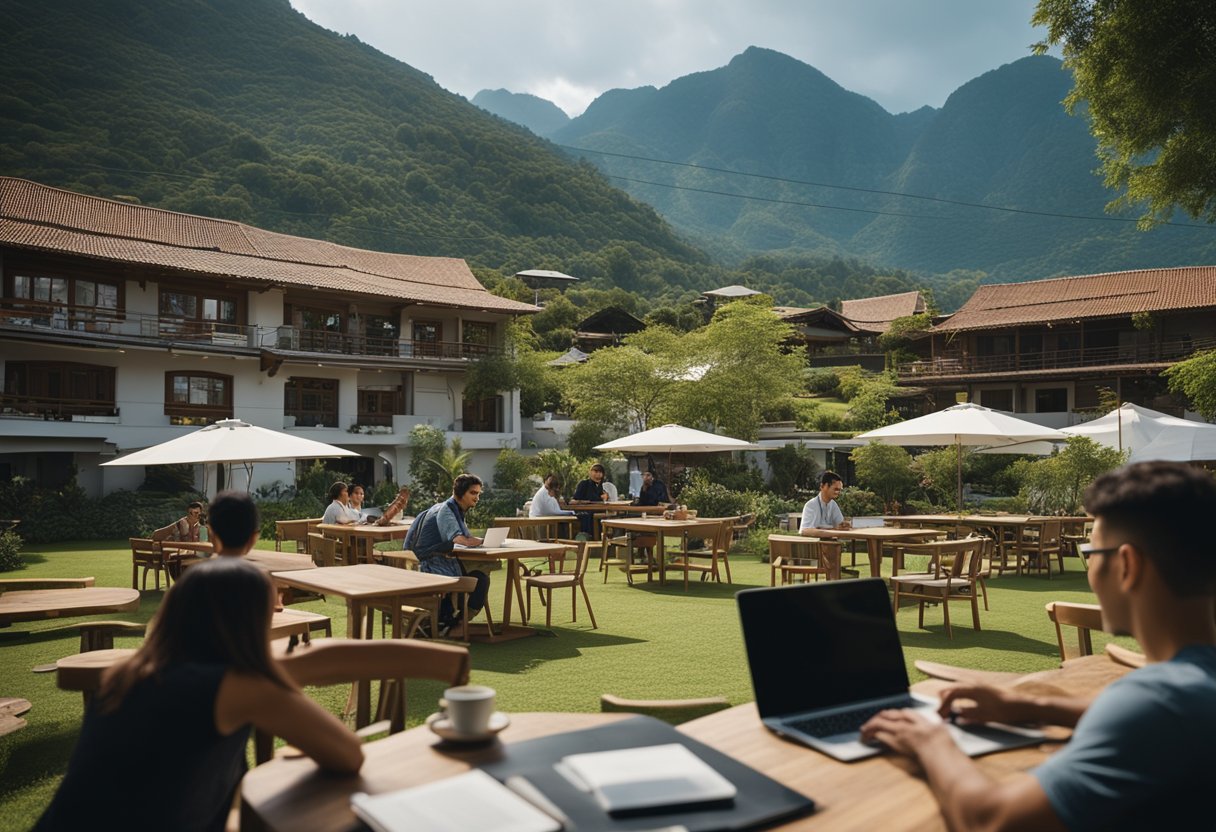Digital Nomad Villages: Embracing the New Era of Work-Life Balance

Updated On: April 30, 2024 by Aya Radwan
The landscape of work has undergone a dramatic transformation in recent years, particularly with the rise of digital nomadism—a way of life that blends the freedom of travel with the ability to work from virtually anywhere in the world. As technology advances and more occupations become untethered from fixed office spaces, digital nomad villages emerge as a viable solution for those looking to merge their professional and wanderlust spirits. These communities are specifically designed to cater to the needs of remote workers, providing infrastructure and services that support a productive work environment and a sense of community amongst like-minded individuals.

The future seems increasingly mobile and global for us, the digital nomads. Combining work and travel is no longer just a dream but a tangible reality, with the creation of villages that offer high-speed internet and coworking spaces and foster social interactions and cultural exchange. However, the shift towards this nomadic lifestyle isn’t without its challenges. There are various factors to consider, such as the local cost of living, visa regulations, and the impact on the host communities. Despite these considerations, the trend of digital nomadism represents more than just a change in where we work; it reflects a broader cultural shift towards finding balance and integration between our professional responsibilities and our desires for exploration and adventure.
Evolving Work Landscape
As we navigate an increasingly connected world, the paradigms of work and travel intertwine to foster novel lifestyles centred around flexibility and freedom.
Rise of Remote Work
The advent of digital technology has given rise to a new era of remote work, where professionals harness the internet to perform their roles from virtually anywhere. This trend has been amplified by the influx of collaborative tools and platforms facilitating communication and productivity for remote workers across continents. A notable example is on the Portuguese island of Madeira, where the village of Ponta do Sol has embraced the shift by establishing itself as the world’s first digital nomad village, catering to the digital nomad community with tailored infrastructure and community support.
Remote work has become an indelible facet of our professional landscape, providing unprecedented freedom and flexibility.
Pandemic Influence on Work Culture
The COVID-19 pandemic has indelibly shaped the way we view our work environments. As societies were propelled into lockdown to mitigate the spread of the virus, businesses and workers were compelled to adapt to remote working models. The enforced pivot demonstrated the viability and benefits of flexible workspaces, solidifying remote work as more than a passing trend. The pandemic catalyzed change and a testbed that highlighted the critical value of adaptability and resilience in our evolving work landscape.
The culture of work has been irreversibly influenced by our collective experience during the COVID-19 pandemic, underscoring the importance of adaptability and setting a precedent for the ongoing integration of remote work into our lives.
Understanding Digital Nomadism
Digital nomadism revolutionises how we approach work and travel, blending flexibility, technology, and a wanderlust lifestyle into a cohesive narrative of modern work culture.
Concept of Digital Nomads
Digital nomads leverage telecommunications technologies to perform their jobs, living a location-independent lifestyle that allows them to travel and work from anywhere in the world. At the core, nomadism revolves around the concept of freedom and mobility. This lifestyle is characterised by fluidity, as digital nomads often shift from one location to another, exploring new cultures and environments while staying professionally active.
- Freedom: Autonomy to choose living location
- Mobility: Ability to travel while maintaining work
- Technology: Access to work tools via digital connectivity
Remote Work and Nomadism
In remote work, nomadism has emerged as a transformative trend. The possibility of working remotely has been a major enabler for digital nomads, decoupling the traditional association of work with a fixed location. This lifestyle is not just about individual flexibility but also represents a paradigm shift in how we perceive the intersection between our professional and personal lives.
Remote work entails:
- Flexibility: Work schedules and environments are adaptable.
- Connectivity: Reliable internet is pivotal for seamless remote working.
- Productivity: Many nomads report heightened productivity away from traditional office settings.
By integrating work with travel, digital nomads effectively challenge the conventional work model, illustrating that productivity is not confined to the four walls of an office. Instead, it thrives where creativity and inspiration flourish – amid diverse settings and experiences that digital nomadism offers.
Digital Nomad Villages Around the World

As the landscape of work shifts towards remote capabilities, digital nomad villages are emerging across the globe, providing vibrant communities for those marrying work and travel.
Madeira’s Pioneering Village
On the picturesque island of Madeira, a project in Ponta do Sol has established one of Europe’s first digital nomad villages. Madeira’s initiative provides high-speed internet, convenient coworking spaces, and a supportive network for digital nomads. This village is not just a location but a concept that embraces the fusion of productivity and island life.
Chiang Mai, Thailand: A Nomad Hub
Chiang Mai has long been a favoured destination for digital nomads in Asia. The city offers an affordable cost of living paired with a robust infrastructure for remote work. Its allure lies in the collaborative environment, highlighted by many coworking spaces and a community that nurtures creativity and the exchange of innovative ideas.
Bali and Lisbon’s Co-Working Communities
Bali and Lisbon are prime examples of how co-working communities can shape the experience of digital nomads. Both destinations boast an enviable blend of cultural richness and modern amenities. From Bali’s rice fields to Lisbon’s historic streets, these regions offer unique backdrops for coworking environments that cater to diverse professional needs and lifestyles.
Key Attractions for Digital Nomads
In recognising the ideal habitats for digital nomads, considering economic aspects, like cost of living, and societal factors, such as access to shared working environments, is essential. These elements combine to create the perfect blend for a nomadic lifestyle that sustains work and personal life balance.
Cost of Living and Quality of Life
The cost of living is pivotal when digital nomads choose their next destination. Affordable living expenses ensure that individuals can sustain themselves comfortably on their earnings. For example, places like Chiang Mai offer a low cost of living and a high quality of life, a balance many remote workers desire.
- Accommodation: Rents that allow for comfortable living without breaking the bank.
- Expenses: Daily costs, such as food and entertainment, that leave room for savings and discretionary spending.
- Healthcare: Access to quality healthcare services at reasonable rates.
In addition, a high quality of life is often characterised by:
- Safety: Low crime rates that allow for peace of mind.
- Community: A supportive and vibrant community of like-minded individuals.
- Leisure: Access to leisure activities that contribute to wellbeing and work-life balance.
Availability of Co-Working and Co-Living Spaces
For digital nomads, the availability of co-working spaces is critical. Destinations like Bali provide co-working spaces that are more than just a desk and wifi. These spaces foster networking and community among remote workers.
- Internet Connection: Reliable and high-speed internet is a non-negotiable for the digital nomad lifestyle.
- Design: Aesthetic and ergonomically designed environments that boost productivity.
Equally important are co-living spaces, which offer:
- Communal living: Spaces designed to share and socialise, reducing the isolation of remote work.
- Facilities: Modern amenities that cater to both work and play.
By harmonising living costs and embracing community-centric work environments, digital nomads can thrive in locales that recognise and meet their distinctive needs.
Challenges and Considerations

When exploring integrating digital nomad villages into our lives, we must carefully consider the complexities and potential difficulties of such a lifestyle shift.
Legalities of Visas and Compliance
Traversing the legal landscape surrounding visas and compliance for digital nomads can be intricate. Understanding the requirements and limitations of various visa types is crucial, as they dictate the duration of stay and work permissions. For instance, some countries offer specific digital nomad visas that accommodate remote workers. In contrast, others might require a standard work visa, which can be difficult to obtain without a local employer. Digital nomads must also be mindful of tax obligations and the rules that govern their work in a destination country, which can vary significantly and pose a risk of non-compliance if not adhered to properly.
Cultural and Social Adaptability
Embracing local culture and achieving social adaptability are vital for the success of digital nomad villages. We must be attuned to and respectful of local customs and societal norms to foster positive relationships with the local community. Successfully integrating into a new community entails more than finding a workplace; it involves learning about local etiquette, participating in community events, and sometimes overcoming language barriers. This adaptability and cultural awareness enable us to thrive socially while avoiding misunderstandings that could strain our relationship with the host community.
Economic Impact on Local Communities

With the rise of digital nomad villages, the repercussions on the economies of host communities are quite considerable. Local businesses often see a renewed influx of customers, and cultural exchange gives rise to tourism-related opportunities.
Support for Local Businesses
We observe that digital nomads tend to boost local economies significantly. Average digital nomads living in a place like Chiang Mai spend considerable amounts on accommodation, food, and entertainment each month. Specifically, spending averages £302 on accommodation, £159 on food, and £245 on entertainment. This influx of spending can become a substantial income source for local businesses, which often see a spike in revenue due to the presence of these global residents.
Cultural Exchange and Tourism Boost
The presence of digital nomads in a community often leads to deeper cultural exchanges. These individuals are typically keen to engage more profoundly with the local environment and culture than the average tourist. For example, in Madeira, the emergence of digital nomad villages has fostered a community environment where nomads are encouraged to integrate and support local sectors. This integration not only helps diversify the local economy but also enhances the richness of the cultural landscape, feeding back into the tourism sector by making these areas more attractive destinations.
Lifestyle and Productivity
This section addresses how Digital Nomad Villages affect work-life balance and well-being while facilitating productivity and networking opportunities.
Work-Life Balance and Well-Being
Digital Nomad Villages offer a unique blend of work and leisure, significantly enhancing well-being by providing a work environment that encourages work-life balance. The relaxed yet stimulating atmosphere often fosters wellness programs initiated by a community manager, which may include yoga sessions and meditation workshops aimed at improving mental health and overall happiness.
Networking and Community Building
Networking opportunities abound in Digital Nomad Villages, allowing for exchanging ideas and forming professional relationships. Regular events and meetups, organised by community managers, encourage collaboration and contribute to a sense of community. A strong support system and communal workspace design enhance networking and productivity, key components of the digital nomad lifestyle.
By integrating professional life with travel and cultural immersion, these villages exemplify a future where work and personal growth go hand in hand.
Infrastructure and Services
In establishing digital nomad villages, the core offerings of high-speed internet and quality accommodation are paramount. These foundational services enable a seamless transition between work and leisure, fostering an environment where digital nomads can thrive.
High-Speed Internet and Accommodation
High-speed internet is the lifeblood of a digital nomad village. We ensure our accommodation options have reliable and fast Wi-Fi connectivity because uninterrupted internet access is critical for remote work. Whether rentals or apartments, accommodation is designed with the nomadic lifestyle in mind, offering comfort and functionality. Our village features:
- Accommodation Options:
- Apartments with dedicated workspaces.
- Shared rental units promoting community living.
Health, Wellness, and Event Facilities
Our village prioritises the health and well-being of its residents. To this end, we’ve established various facilities dedicated to maintaining a healthy lifestyle. Moreover, community is fostered through organised events that encourage both professional networking and social engagement:
Health and Wellness:
- On-site gyms and yoga studios.
- Regular wellness workshops.
Event Facilities:
- Event halls for workshops and conferences.
- Locations for community gatherings and social mixers.
Future Trends in Digital Nomadism
The landscape of work and travel is perpetually evolving, and we’re poised on the cusp of exciting developments set to redefine the digital nomad lifestyle. Central to this evolution are the emerging hubs beckoning digital nomads worldwide and the innovative integration of AI and technology in their work lives.
Emerging Destinations for Nomads
We are witnessing a rise in previously under-the-radar locations, transforming into hotspots for digital nomads. These emerging destinations offer compelling mixes of connectivity, affordability, and quality-of-life enhancements. Locations such as Portugal’s Madeira, which has established its dedicated digital nomad village, are at the forefront of this trend, providing a template for what the future of work looks like when combined with travel.
Top Emerging Destinations:
- Madeira, Portugal
- Bali, Indonesia
- Tbilisi, Georgia
Each of these destinations provides a unique cultural tapestry alongside state-of-the-art facilities tailored to the needs of the globally mobile workforce.
Integration of AI and Digital Tools
As the digital nomad trend swells, so does the need for advanced technological tools, with AI leading the transition. No longer novelties, AI-powered solutions and digital tools are streamlining workflows, enhancing productivity, and enabling seamless communication, regardless of physical location.
Essential Digital Tools for Nomads:
- AI-driven language translation apps
- Project management software
- Virtual collaboration platforms
By integrating these AI-driven technologies, digital nomads are set to experience unprecedented efficiency and fluidity in how they work and interact with clients across the globe. We are at the forefront of witnessing these exciting advancements redefine what it means to work remotely, providing digital nomads with the freedom to excel professionally while exploring the world.
Marketing and Growth Strategies
Marketing and growth strategies are pivotal for popularising Digital Nomad Villages in the evolution of work and travel. Establishing these destinations as desirable hubs for remote work relies heavily on strategic branding and innovative content marketing.
Branding Digital Nomad Destinations
When branding Digital Nomad Villages, it’s essential to encapsulate the unique selling propositions of each location. We emphasise the local culture, cost of living, and quality of life, making it clear why a remote worker would choose to reside there. For example, the “Digital Nomad Village” concept on Madeira Island is successfully branded by highlighting the island’s supportive community for remote workers.
Branding extends beyond a simple logo or tagline; it involves creating a comprehensive image that resonates with the target demographic. Our strategy includes:
- Identity: Crafting a strong, recognisable brand identity that embodies the spirit of a nomadic lifestyle.
- Values: Promoting sustainable living and community integration aligns with the preferences of today’s remote workforce.
- Experience: Ensuring that every touchpoint, from website to stay, conveys the brand’s core message and values.
Social Media and Content Marketing
Our social media and content marketing approach focuses on creating and sharing relevant, valuable content that sparks curiosity and engagement. Social media platforms like Instagram and LinkedIn showcase daily life in nomad villages, while blogs and articles provide deeper insight into the benefits and experiences.
The content marketing strategy hinges on these cornerstones:
- Engagement: Foster a community presence and interact with followers to build relationships and encourage sharing.
- Quality Content: Produce high-quality, informative content that adds value and positions us as leaders in the digital nomad sphere.
- Analytics: Regularly analyse performance data to tweak and refine our strategy for maximum impact and reach.
By adhering to these strategies, we aim to cement our position as prime destinations for digital nomads, inviting a new wave of remote workers to explore and enrich their lives within our vibrant villages.
Frequently Asked Questions
In this section, we’ll tackle some of the most common queries related to the digital nomad lifestyle, including the practicalities of becoming a digital nomad, job opportunities, age considerations, supportive countries, and the specifics of digital nomad visas.
How does one become a digital nomad?
To become a digital nomad, one typically transitions their work to be fully remote, often through fields such as tech, writing, or online marketing. Acquiring the necessary tech, skills, health insurance, and a banking plan is also important.
What are the typical job opportunities available for digital nomads?
Job opportunities for digital nomads often include freelance writing, programming, web design, and virtual assistance. Large-scale offline nomad events also offer networking opportunities that can lead to jobs.
Can individuals over 30 still embark on a digital nomad lifestyle successfully?
Yes, individuals over 30 can embark on a digital nomad lifestyle successfully. Age is less a factor than one’s ability to adapt to change and manage a remote work lifestyle effectively.
Which countries offer the best infrastructure and support for digital nomads?
Countries like Estonia are at the forefront, offering Digital Nomad Visas and communities designed to support this lifestyle. Others, such as Costa Rica, Portugal, and Mexico, rank highly for their infrastructure and support.
What are digital nomad visas, and how do they work?
Digital nomad visas allow remote workers to live in a country while working for foreign employers. They often have requirements such as proof of income and health insurance.
What is the average income of individuals living a digital nomad lifestyle?
Income varies widely among digital nomads. However, many aim for a comfortable income that affords a good quality of life while allowing for savings, typically mirroring incomes in tech and creative industries.






